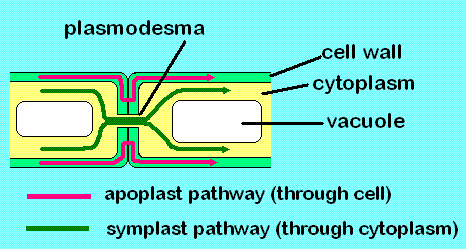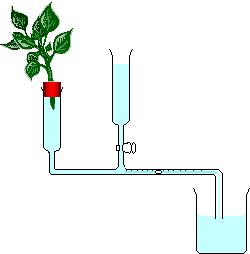A-level Biology/Transport/multicellular plants
Water Transport
[edit | edit source]Water enters a plant through the hair on the root, and moves across the root cells into the xylem, which transports it up and around the plant. That, and solutes are moved around by the xylem and the phloem, using the root, stem and plant.
Root
[edit | edit source]
Water enters the root through the root hair, and then takes one of three paths (apoplast, symplast and vacuolar) to the xylem vessel.
Soil to root hair
[edit | edit source]A root hair is a simple extension of the epidermis of a root cell. It reaches into the soil to absorb water by increasing the surface area and therefore the rate at which water can be absorbed by osmosis. Some plants have fungi which act like fine roots, absorbing nutrients from the soil for the plant. Water moves into the root hair cells by osmosis because it is moving down a water potential gradient, since a root cell has a relatively low water potential due to its inorganic ions and organic substances. Water enters through the membrane and into the cytoplasm and vacuole. The water is moved by osmosis from soil to root whereas minerals and salts move through active transport or sometimes diffusion.
Root hair to xylem
[edit | edit source]From the root hair cells, water again moves by osmosis down a concentration gradient toward the xylem, and can take one of three paths - apoplast, symplast, or vacuolar.
The apoplast pathway is where water takes a route going from cell wall to cell wall, not entering the cytoplasm at any point. The symplast pathway is where water moves between cytoplasm/vacuoles of adjacent cells. However, the apoplast pathway can only take water a certain way; near the xylem, the Casparian strip forms an impenetrable barrier to water in the cell walls, and water must move into the cytoplasm to continue. This gives the plant control over the ions that enter its xylem vessels, since water must cross a plasma membrane to get there. The vacuolar pathway moves molecules through the vacuoles only of the plant.
Xylem
[edit | edit source]The xylem is constructed of three main elements:
- Vessel elements, including tracheids - cells involved in water transport
- Fibres - elongated cells with lignified walls that support the plant
- Parenchyma cells - normal plant cells, except no chloroplasts.
Xylem vessels
[edit | edit source]These vessel elements make up the xylem - and are many elongated cells laid end to end, and normal plant cells have walls strengthened by lignin - a complex organic polymer deposited in the cell walls of many plants, making them rigid and woody, a hard strong substance that is impermeable to water, and is designed to provide structure and strength to the plant. When these plant cells are strengthened by lignin, the cell inside dies, leaving a space inside. However, in some plasmodesmata, there was no lignin laid down and these appear as gaps in the xylem vessel, known as pits. These have permeable unthickened cellulose cell wall.
Thus, a continuous tube is formed, known as the xylem vessel. Xylem vessels are huge. They are used to transport the minerals and water and provide support to the plant.
Tracheids
[edit | edit source]Tracheids are dead cells with lignified walls, but they do not have open ends and thus do not form vessels - their ends are tapered. All plants have them, but primitive plants use them as main conducing tissue.
Translocation
[edit | edit source]The transport of soluble organic substances (sometimes called assimilates) within a plant is known as translocation. The solutes are transported in sieve elements, found in the phloem tissues, along with other companion cells, parenchyma and fibres.
Phloem Components
[edit | edit source]Sieve Elements
[edit | edit source]Sieve Elements are specialised cells, with few mitochondria and endoplasmic reticulum, no nucleus or ribosomes. Where two ends of sieve elements meet, a sieve plate is formed, made from the walls of both elements, with large pores allowing free flow of liquids between them.
Companion Cells
[edit | edit source]Companion cells are normal plant cells with high numbers of mitochondria and ribosomes, and have many plasmodesmata pass through to their neighbouring sieve cell walls, making direct contact between the cytoplasm of companion cells and sieve elements. Plasmodesmata allows diffusion of sucrose into phloem sieve element during active loading of sucrose.
Mass Flow
[edit | edit source]Mass flow is the theory by which we think solute transport occurs in plants. Any area where sucrose is produced in a plant is known as a source, and any area where it is taken out (usually, used in respiration) is known as a sink.
- Sucrose is actively transported into the sieve tubes of the phloem at the source, lowering the water potential inside the sieve and so water enters the tubes via osmosis, creating a higher pressure inside the sieve tubes at the source.
- At the sink, sugars leave the phloem to be used up, increasing the water potential inside the sieve tubes, so water leaves via osmosis, lowering the pressure inside the sieve tubes.
- The result is a pressure gradient between source to sink, pushing sugars to where they're needed.
Evidence
[edit | edit source]Supporting evidence
- When the phloem is cut, sap oozes out, showing a pressure gradient.
- Suitable water potential gradient between leaves and other plants, in theory.
- Phloem sap has a high pH, which is to be expected since hydrogen ions are actively transported out of the cell.
- ATP is present in phloem sieve elements in high numbers since it is required for active transport of hydrogen ions.
Evidence against
- Sugar travels to many different sinks.
- Sieve plates are a barrier to mass flow.
- Doesn't require living cells, but phloem cells are alive.
Transpiration
[edit | edit source]Transpiration is the loss of water vapour from the leaves of a plant.
Xylem to leaf
[edit | edit source]As water evaporates from the leaf, a constantly occurring process, more water is taken in to replace it. The removal of water reduces the hydrostatic pressure (pressure exerted by a liquid). Since this pressure becomes lower at the top of the xylem vessel than at the bottom, this pressure difference causes water to move up the xylem vessels, just as in a straw.
This process is known as mass flow - along with the fact that water molecules move together as a body of water - aided by water's property of being cohesive, and attracted to the lignin in the walls of the xylem vessels, known as adhesion.
Once water is in the leaf, it can be lost through the stomata, if there is a concentration gradient that it can go down. Stomata are small pores in direct contact with the air outside. This process is known as transpiration.
Root pressure
[edit | edit source]Plants can also increase the hydrostatic pressure at the bottom of the vessels, changing the pressure difference. They do this by cells surrounding the xylem vessels to use active transport to pump solutes across their membranes and into the xylem, lowering the water potential of the solution in the xylem, thus drawing in water from the surrounding root cells. The influx of water at the bottom of the xylem increases the pressure.
Transpiration rate
[edit | edit source]
The rate of transpiration is affected by:
- Humidity, which affects the water potential gradient outside the leaf, by making the gradient more or less steep. Low levels of humidity would cause the gradient to be steep, meaning that transpiration would increase as water molecules would find it easier to escape the leaves. A high humidity level would have the opposite effect, reducing the transpiration rate.
- Wind speed, which affects the water potential gradient outside the leaf. the faster the speed, the less humid the area around the leaf becomes, as a result, the water potential gradient would be come more steep and more evapotranspiration would occur.
- Temperature, which makes it easier for water molecules to escape from the leaves (this happens when it is hot). As temperature increases, the water molecules are able to move more rapidly. The evaporation rate also increases with temperature. Warm air is also able to hold more moisture than cold air, meaning that water can diffuse into warm air more easily, and this contributes to the transpiration rate.
- Light, which stimulates the stomata to open allowing gas exchange for photosynthesis, and as a side effect this also increases transpiration. This is a problem for some plants as they may lose water during the day and wilt.
The transpiration rate is measured by a potometer, a device that measures the rate at which a plant stem takes up water, since measuring transpiration directly is difficult.
Xerophytes
[edit | edit source]Xerophytes are plants which have various adaptions (below) to reduce transpiration and thus water loss.
- Reduced stomata
- Swollen stem, storing water
- Swollen leaves to store water
- Huge surface area for roots
- Leaves reduced to spines (cactus), reducing surface area for water loss
- Take in CO2 at night so they can close their stomata in the day to reduce water loss
- Thick, waxy water-resistant cuticle on the epidermis to reduce water loss
- Sunken stomata (in pits), where water vapour is sheltered from the wind
- Hairlike projections, called trichomes, on the leaf surface to reduce the effect of high wind speed
- Stomata closed during the day when transpiration rate is usually the highest
